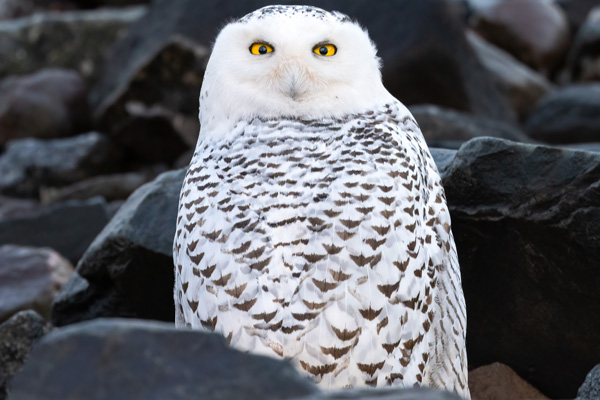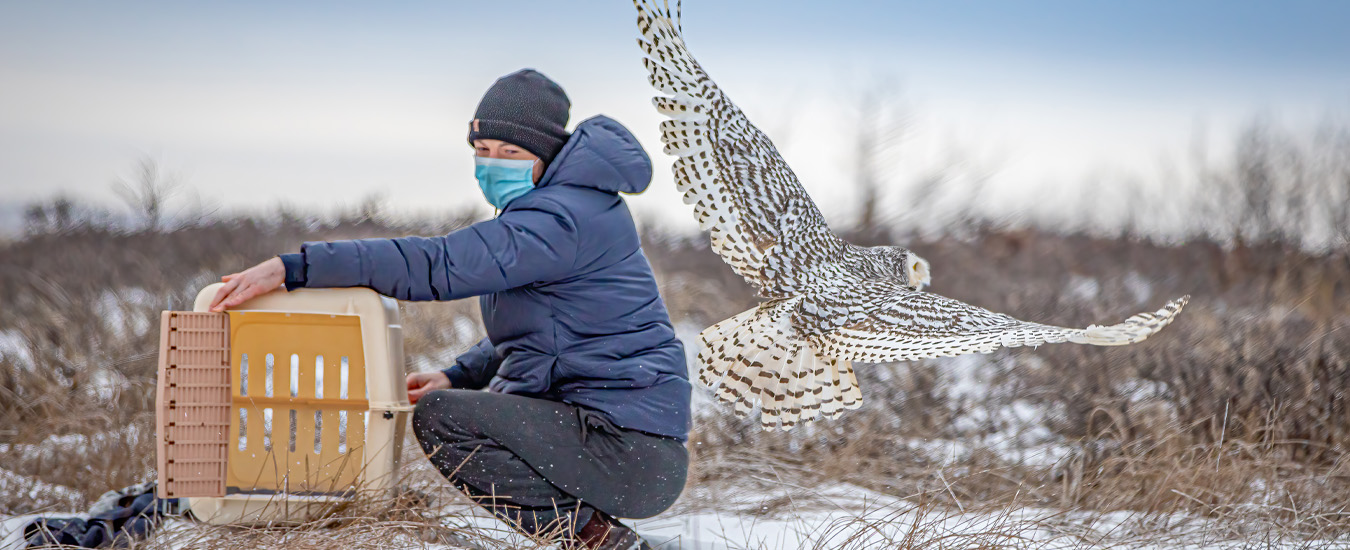A photographer shares his images, and advice on how to safely observe the beautiful birds
Few animals have come to represent the Canadian north more than the snowy owl. These majestic creatures, with their beautiful white feathers and piercing yellow eyes, are amongst the most striking in our country. The majority of these owls live their entire lives in the northern tundra of Canada, but some migrate north to the ice fields in winter, and some migrate south, giving us the opportunity to encounter these amazing birds.
As a photographer and nature lover, the snowy owl has always been on my bucket list as an animal I dreamed of seeing and photographing. For years, each winter, usually around December, photos and stories began to emerge about snowy owl sightings around the Maritimes. I would listen in awe to the stories told by friends of snowy owls “on the roof of their house, on the dirt road across the street”; even on top of their car. Each time I heard of a sighting I ventured out with my camera and very long and heavy zoom lens, and hiked kilometres in search of the birds, and often would be told I had just missed it. I even drove from my home province of PEI in search of snowy owls!
Last year, there was what scientists call an irruption. This is a rare occasion when a large number of snowy owls migrate south. Usually, the owls that come south—the ones we see here—are juvenile birds. These young owls are kicked off the northern tundra by larger, older birds, and fly south in search of food and territory. The problem with this situation is that by the time the birds make it to the Maritimes, they are usually starving. Because they are young, inexperienced hunters, and not used to our landscape or food sources, they often starve to death once they arrive. The other main reason many young owls die is due to stress caused by humans. Snowy owls migrate to areas which look similar to the tundra they come from. In many cases in the Maritimes, this means they arrive in populated places like the sand dunes in PEI’s National parks, golf courses, open fields, even airport fields and runways.

Owl heads can rotate 180 degrees, giving them the ability to see all around them without having to move.
Snowy owls are not used to seeing humans, and humans are very excited to see them. Unfortunately, what most people do not know is that this owl species will not eat when stressed. When people get close to them to take photos or take a closer look, not only are they stressing the birds, often the owls end up flying off, using up what precious little energy they have left after their long journey south.
Finally, last winter, after many years of searching and stories, I had my chance to see and photograph a snowy owl. I had been getting up early each morning to drive to PEI National Park before work to look for owls. One dreary, grey morning I arrived around sunrise to see the taillights of a car stopped in the middle of the road. My heart started racing as I knew why they were stopped. I drove towards the taillights, but just before I got there the truck pulled away. It was a park vehicle and pulled into a parking lot ahead. I pulled in beside to put down my window. “Have you seen any snowy owls?” I asked. “Yep, you just missed it by 30 seconds, it flew off in that direction.” The entire day I kept thinking about the experience, I thought as soon as work ended, I was going to head back out before sunset.
I messaged my wife and told her to meet me after work at the park. When we arrived it was dark and grey, but warm. As we entered the park we saw a park vehicle and waved it down. “Did you see any snowy owls?” I asked. “Yes, just up the road on the top of the dune.” My heart started racing again.
We drove slowly down the road and to our joy there they were—not one, but two snowy owls about a kilometre apart on the high points of two separate dunes. We stopped to look and take a few photos but the owls were about 500 metres away so we decided to take a look from the beach. When we got closer, sure enough there they were, perched high and looking around constantly. We were able to get close enough for a good look and get some photos without disturbing the birds.
A few weeks later, I heard that the Atlantic Vet College had a snowy owl that they were rehabilitating. I contacted some friends who worked there and was able to photograph the release of this owl. It was an absolute pleasure to see the joy on the staff’s faces as they set it free and watched it fly off.
Later, in April, I had my final experience with a snowy owl that year. I was out to photograph seal pups when to my shock I came upon a very healthy snowy owl, probably just about to fly back north to its home. It was a beautiful spring day, and I was able to spend a good hour watching and photographing it as it hunted, being harassed by crows.
If you are ever lucky enough to experience a snowy owl in the wild, recognize that it is a gift and give it the love and respect it deserves. Hopefully it will leave healthy to come back again next winter.
If you encounter a snowy owl on your travels, here are a few tips to ensure that you give them the best possible chance of surviving though the winter.
- Please do not post photos or reveal the locations of the owls.
Last year, at least two snowy owls who migrated to PEI National Park died because of stress caused by humans. The word got out that there were owls at the park and many, many, people went to
see them, not understanding the stress they were causing, and the owls starved to death. Even though it is very exciting to see them, the best thing to do is hold onto your photos and post them at a later date; and try to only show photos which do not give away locations. - Do not get too close. Usually, anything closer than about 100 feet or 30 metres will stress out the birds. The easiest way to tell, is that if the owl is only looking at you and not looking around, then you are too close. I use an extremely long zoom lens and often still have to crop my photos.
- If you see an owl that looks injured or is not moving, contact your local conservation officers. They will know what to do and sometimes can save the owl. Last year a snowy owl was saved from severe emaciation by the hard work of the Atlantic Vet College on PEI.

